A Description of Bhu-Mandala (The Intriguing Vedic Universe, ch.1)
The Vedas explain that vast as it may be, our universe is just one amongst many universes floating in the causal ocean, just like balls floating on water. What is inside?
'The Intriguing Vedic Universe' was my first book on Vedic cosmology, explaining the mysterious universe described in the Srimad Bhagavatam. Although explained in an enigmatic way, the model of the universe described in the Puranas and other books gives a surprisingly detailed description of the world surrounding us. It describes not just the physical aspects, in a level of detail that rivals modern science, but also the metaphysical aspects, the missing aspect that is missing in the modern perspective. Like practically everything else in the Vedas, however, this knowledge is not easily accessible, and I hope this book can help you to start understanding the mysteries of it.
Chapter 1: What does the Bhagavatam say?
The first step to understanding the model of the Universe given in the Puranas is to study it. This same explanation is repeated in the different Puranas, but to keep the description short, here we will focus on the description of the Universe offered in the 5th canto of the Srimad Bhagavatam. In this chapter, I will just give a short description of the model, and the rest of the book will be dedicated to explaining it.
The Srimad Bhagavatam compares our Universe to a coconut. A coconut is composed of several layers, with a hollow space inside that is half-filled with water. Because of the coverings, the space inside the coconut is completely dark. A living entity living inside a coconut would never see the light shining outside.
The Vedas explain that vast as it may be, our universe is just one amongst many universes that float in the causal ocean, just like balls floating on water. The entirety of the causal ocean, including all the universes, equals just one-quarter of the total creation. Outside there is the spiritual realm that represents the other three quarters.
Each universe is composed of seven coverings and a hollow space in the middle. Half of this space is filled with subtle water, over which Lord Garbhodakasayi Vishnu lays down on the bed of Sesa Naga, while the other half is empty. This is the space where the Universe is created by Lord Brahma.
All the distances mentioned in the Srimad Bhagavatam are given in yojanas. There is debate related to the exact length of the yojana, but Srila Prabhupada in his commentary adopts the probable length of 8 miles per yojana for the verses of the Srimad Bhagavatam. Other authors accept different measures, substantiating their hypotheses with the help of experimental knowledge.
The main structure of the Vedic Universe is Bhu-Mandala. Situated in the horizontal middle of the empty space, Bhu-Mandala is 500,000,000 yojanas (4 billion miles) in diameter, which is roughly the size of our solar system.
In Srimad Bhagavatam 5.16.1, it’s mentioned that “the radius of Bhu-mandala extends as far as the sun spreads its light and heat and as far as the moon and all the stars can be seen”. This verse should not be taken literally, since SB 5.20.37 mentions that the light of the sun extends only up to the Lokaloka mountain (which is positioned in the middle of Bhu-Mandala), and also because different beings may see things in different ways, but it gives us an idea of its size.
Bhu-Mandala (source: Sadaputa Prabhu)
Bhu-Mandala is formed by a sequence of seven concentric islands, separated by oceans. These oceans came into existence from the ditches created by the chariot of Maharaja Priyavrata (SB 5.1.31).
It's mentioned that the planetary system of Bhu-Mandala resembles a lotus flower and the seven islands resemble the whorl of the flower.
The island of Jambudvipa
At the center of Bhu-Mandala lies the island of Jambudvipa, of which Bharata-Varsa is part. This island is circular, with a width of one hundred thousand yojanas. To be able to understand this model we need to first forget about the model offered by modern astronomy and concentrate solely on the features of Bhu-Mandala as described in the Srimad Bhagavatam. We will try to harmonize this model with what we see when we look at the sky in the subsequent chapters of this book.
Jambudvipa at the center of Bhu-Mandala, surrounded by the salt ocean
(source: Sadaputa Prabhu)
Jambudvipa is subdivided into nine separate portions of land, each one with a length of 9,000 yojanas. These tracts of land are inhabited by different races of intelligent beings and are separated by very tall mountains.
At the center, there is Ilavrta Varsa, which contains the Sumeru mountain, which is made from solid gold. This mountain looks like an inverted golden cone that is very similar in form to the pericarp of a lotus flower. The presence of this mountain is a feature that makes Bhu-Mandala look very much like a lotus flower.
Another significance of this golden mountain is that it makes Jambudvipa look like an arena of a fire sacrifice. This reminds the inhabitants that this is a place for performing yajnas with the purpose of ascending into higher realms, instead of just spending our time in useless sense gratification.
This mountain is extraordinarily tall. It is mentioned that the height of the mountain is also 100,000 yojanas, the same measurement as the width of Jambudvipa. Of this, 16,000 yojanas are buried inside the ground, and thus the total height of the visible part of the mountain is 84,000 yojanas.
A normal mountain has a large base and a narrow peak, but Sumeru is inverted, and thus it is narrow at the base and wide at the peak. The width of the mountain at the top is 32,000 yojanas, and this space is occupied by nine towns dedicated to Lord Brahma and the eight principal demigods. Although all these demigods have their own planets, they also preside over these cities. Sometimes it is described that these cities at the top of Mount Sumeru are like summer villas for these demigods.
On the four sides of Sumeru are four smaller mountains, called Mandara, Merumandara, Suparsva, and Kumuda, that are like its belts. These mountains are 10,000 yojanas in length. At the top of these four mountains, there are four gigantic trees, positioned like flagstaffs. These trees have a height of 1,100 yojanas and their branches spread over the same length.
Other verses of the 16th chapter of the 5th canto describe other geographical features of the island of Janbudvipa, including lakes and other mountains. All these features are absolutely gigantic compared with the geographical features of our planet. Just to compare, the Earth of our sensory experience has a diameter of 7,926 miles (991 yojanas), which is less than the size of one of the four trees positioned at the top of the above-mentioned mountains! Similarly, the Himalayas we can experience with our earthly senses have a height of just five and a half miles, which is nothing compared with the 672,000 miles of the visible part of the Sumeru mountain.
It’s also important to note that SB 5.16.9 mentions that the Himalayas are 10,000 yojanas tall. Obviously, the sages who transmitted this knowledge were intelligent enough to understand the difference between a mountain 5.5 miles tall and 10,000 miles tall. This hints at the idea that different features of the Vedic Universe may be perceived differently by beings with different sets of senses and in different stages of spiritual evolution. This is something we will examine more carefully in the subsequent chapters of this book.
Surrounding Jambudvipa is a great ocean of salt water that also extends for 100,000 yojanas, the same length as the island itself. If we could see this structure, the view would be breathtaking. Sadaputa Prabhu made at his time a 3D rendering of Jambudvipa with accurate proportions:
Can you see the minuscule trees on top of the mountains that surround Mount Meru? Each of these trees is bigger than our planet. This gives an idea of how gigantic this structure is.
The river Ganges flows from the celestial planets to the top of Sumeru mountain, where it divides into four branches that flow in the four directions, bathing different portions of Jambudvipa, and ultimately flows into this salt ocean. The Ganges we see on our planet is a feature of the Alakananda branch, that flows through Brahmalaya and reaches Bharata-varsa after passing through many mountains.
We live in Bharata Varsa, which is the field of activities where souls take birth to create a new set of karma that will enjoy or suffer in their subsequent lives. Inhabitants of Bharata Varsa are supposed to worship the Lord by following the Varnasrama system.
The other varsas that are part of Jambudvipa are celestial places, inhabited by souls who are enjoying the results of their past karma. A different incarnation of Krsna presides over each of these varsas and is worshiped by the inhabitants. You can find the complete description in the 18th chapter of the 5th canto.





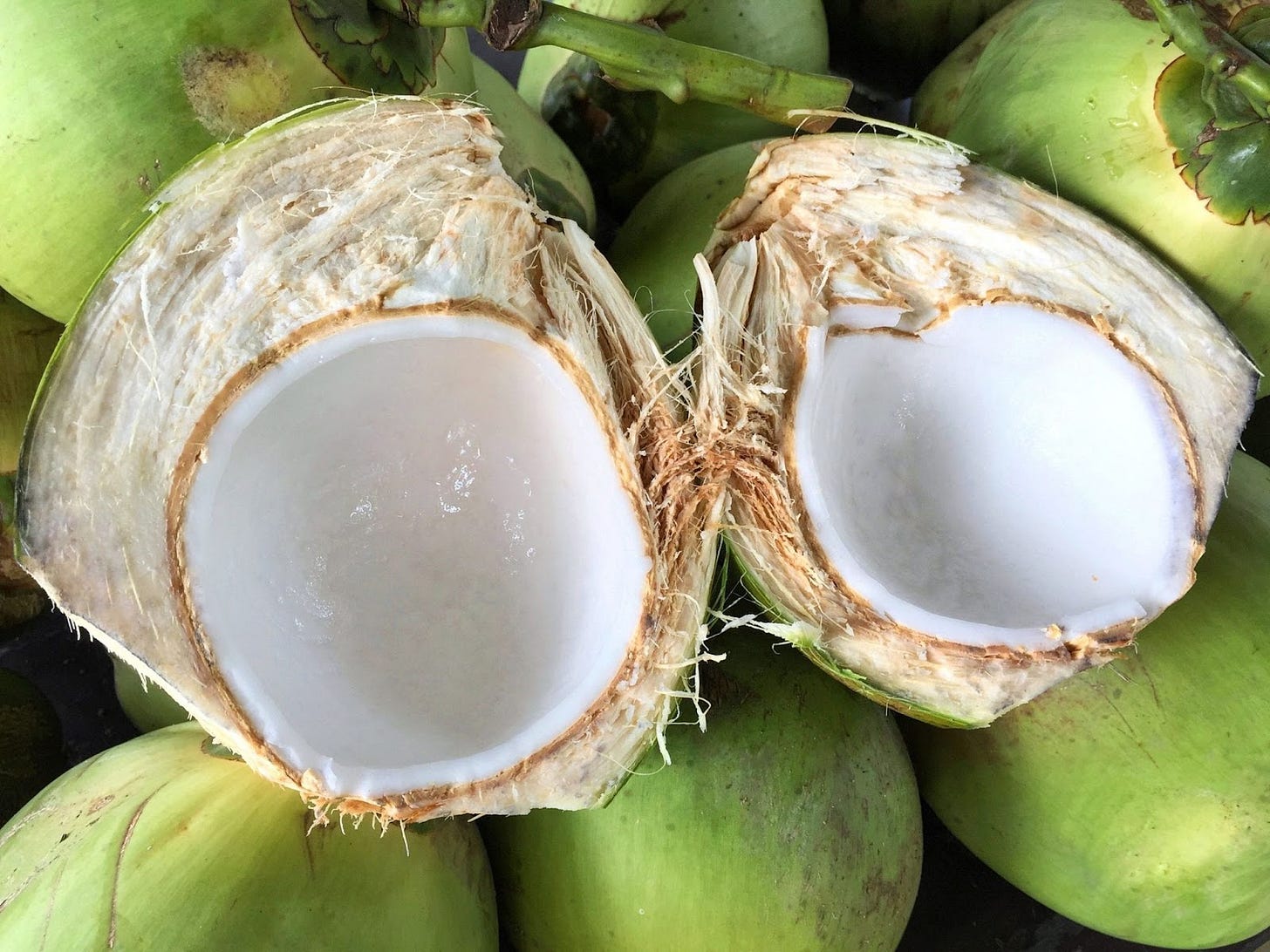
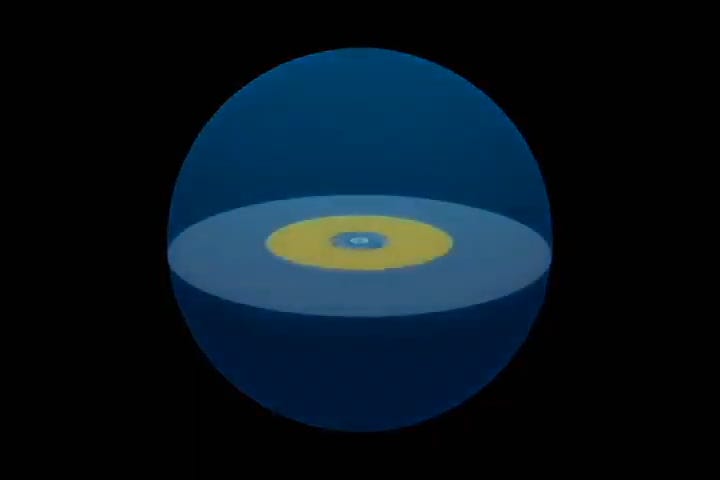
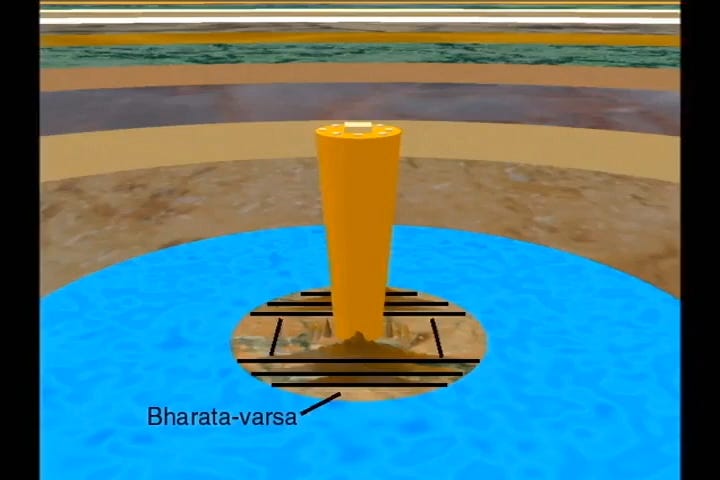
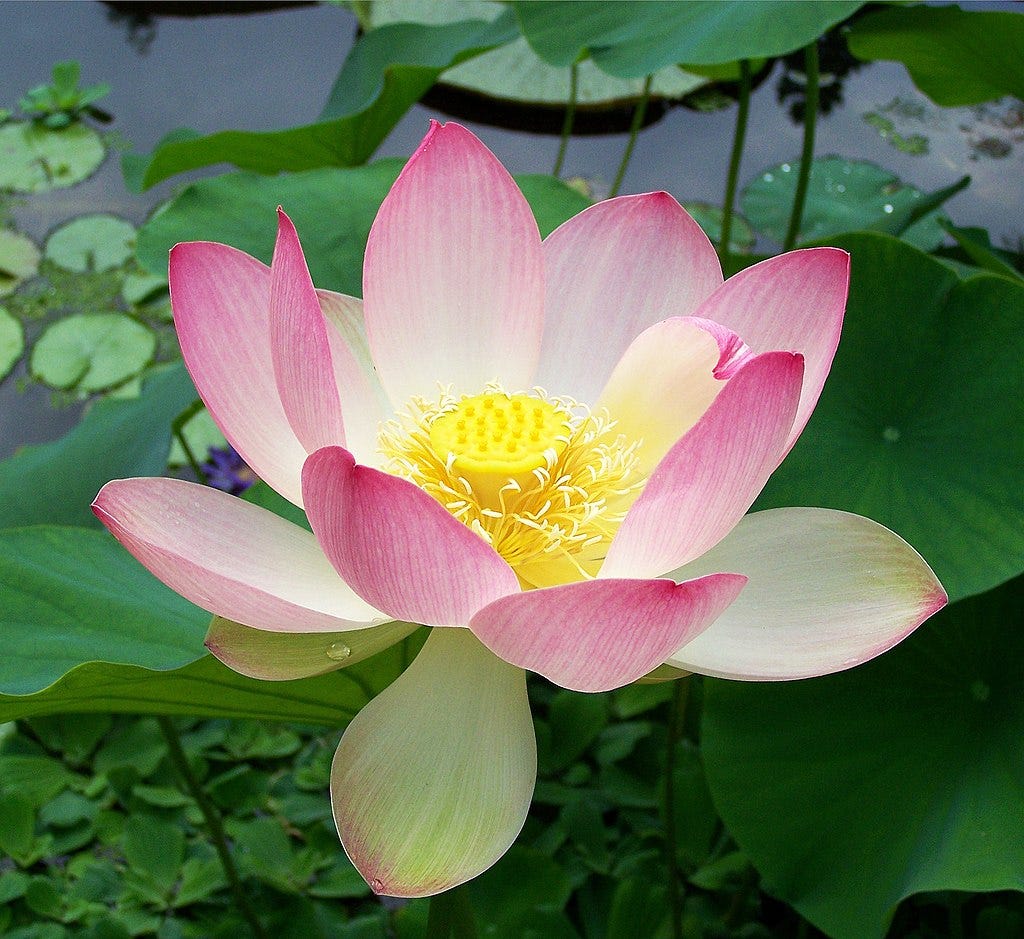
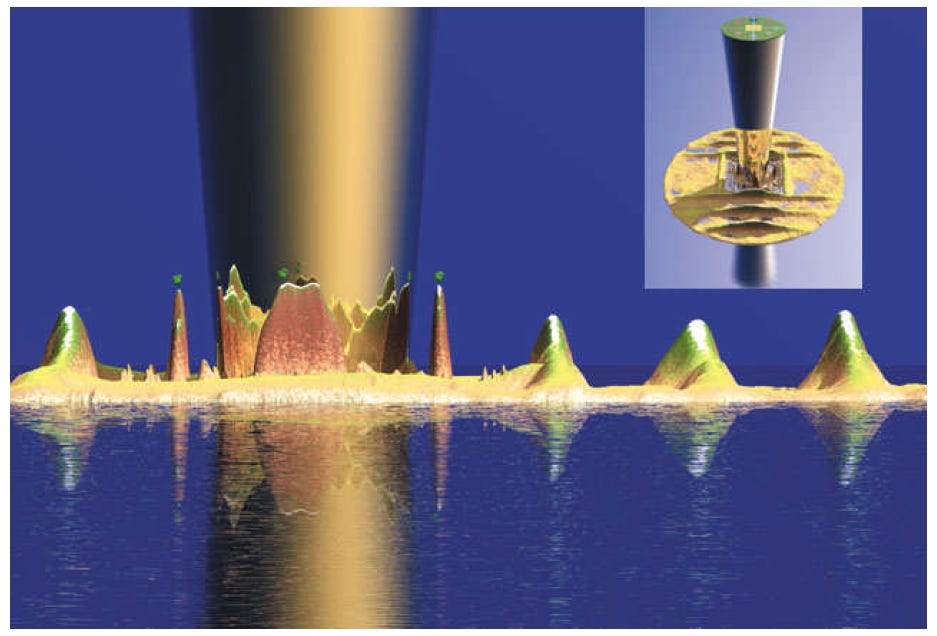
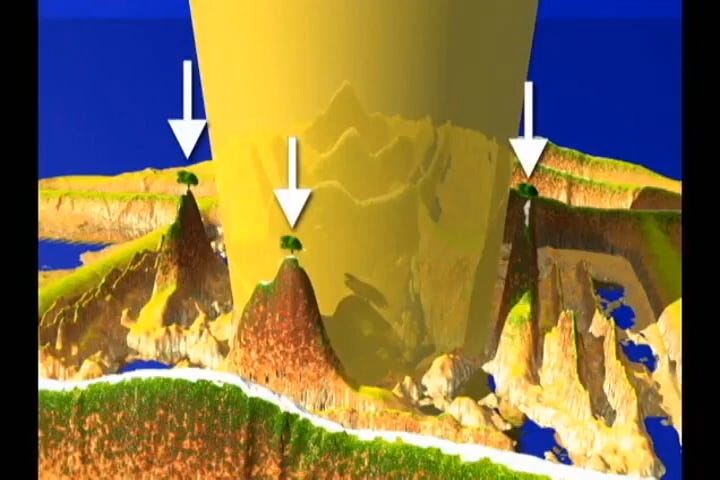
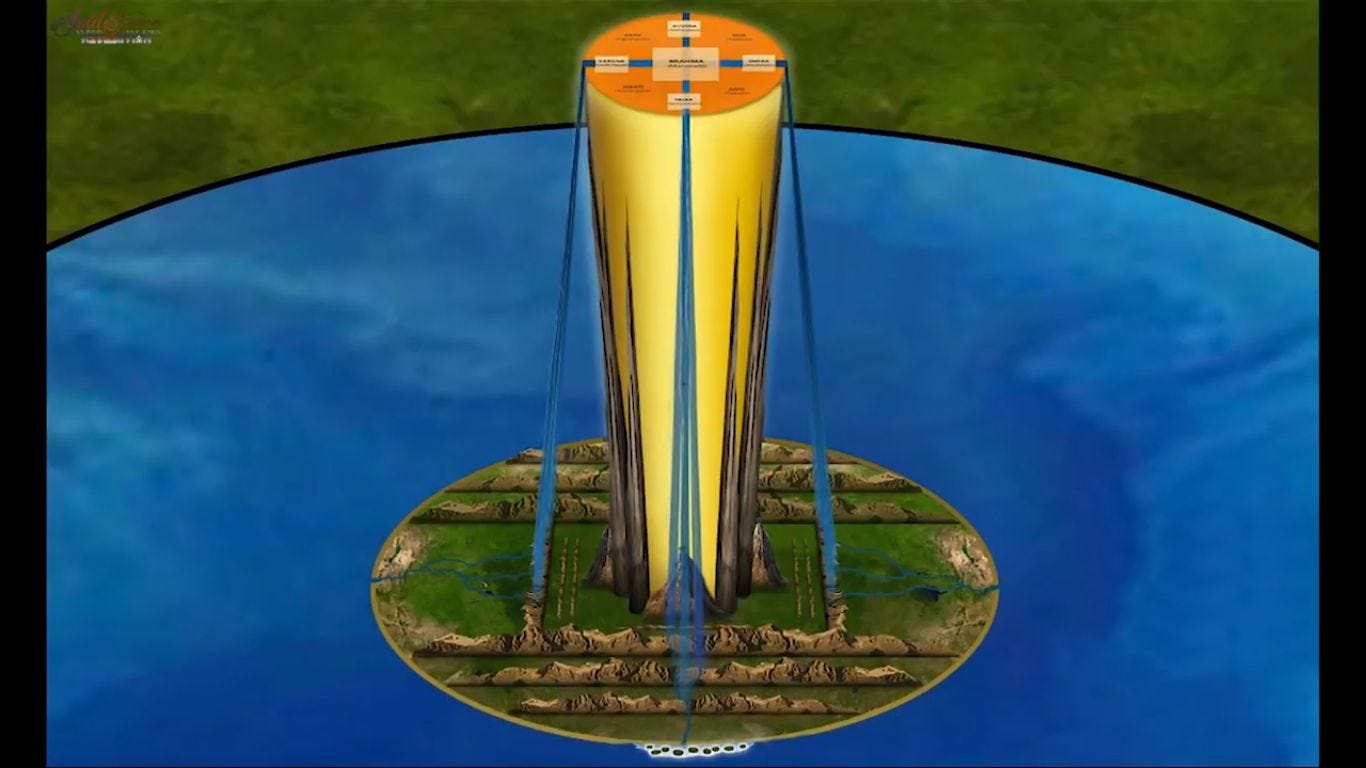
These giant trees remind me of the World tree of the fantasy world though they are very small compared to the original ones.
Thank you prabhu 1st time I understood the structure of bhumandal so nicely